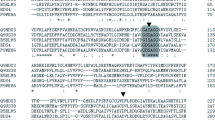Abstract
5-Enolpyruvylshikimate 3-phosphate synthase (EPSPS) is the primary target for the broad-spectrum herbicide, glyphosate. Improvement of EPSPS gene for high level of glyphosate tolerance is important to generate glyphosate-tolerant crops. In this study, we report the isolation and characterization of EPSPS genes of glyphosate-tolerant Pseudomonas nitroreducens strains FY43 and FY47. Both P. nitroreducens strains FY43 and FY47, which showed glyphosate tolerance up to 8.768% (518.4 mM, 32 × higher than field application), were isolated from soil samples collected from oil palm plantation with a long history of glyphosate application. The glyphosate tolerance property of EPSPS genes of strains FY43 and FY47 was functionally characterized by expressing the genes in Escherichia coli strain BL21(DE3). Error-prone PCR was performed to mutagenize native EPSPS gene of strains FY43 and FY47. Ten mutagenized EPSPS with amino acid changes (R21C, N265S, A329T, P71L, T258A, L184F, G292C, G292S, L35F and A242V) were generated through error-prone PCR. Both native and mutated EPSPS genes of strains FY43 and FY47 were introduced into Escherichia coli strain BL21(DE3) and transformants were selected on basal salt medium supplemented with 8.768% (518.4 mM) glyphosate. Mutants with mutations (R21C, N265S, A329T, P71L, T258A, L35F, A242V, L184F and G292C) showed sensitivity to 8.768% glyphosate, whereas glyphosate tolerance for mutant with G292S mutation was not affected by the mutation.





Similar content being viewed by others
References
Aristilde L, Reed ML, Wilkes RA et al (2017) Glyphosate-induced specific and widespread perturbations in the metabolome of soil Pseudomonas species. Front Environ Sci 5:34
Baerson SR, Rodriguez DJ, Tran M et al (2002) Glyphosate-resistant goosegrass. Identification of a mutation in the target enzyme 5-enolpyruvylshikimate-3-phosphate synthase. Plant Physiol 129:1265–1275
Bartel B (1997) Auxin biosynthesis. Annu Rev Plant Physiol Plant Mol Biol 48:51–66
Benslama O, Boulahrouf A (2013) Isolation and characterization of glyphosate-degrading bacteria from different soils of Algeria. Afr J Microbiol Res 7:5587–5595
Eschenburg S, Healy ML, Priestman MA et al (2002) How the mutation glycine96 to alanine confers glyphosate insensitivity to 5-enolpyruvyl shikimate-3-phosphate synthase from Escherichia coli. Planta 216:129–135
Fitzgibbon JE, Braymer HD (1990) Cloning of a gene from Pseudomonas sp. strain PG2982 conferring increased glyphosate resistance. Appl Environ Microbiol 56:3382–3388
Froger A, Hall JE (2007) Transformation of plasmid DNA into E coli using the heat shock method. J Vis Exp 6:253
Funke T, Healy-Fried ML, Han H et al (2007) Differential inhibition of class I and class II 5-enolpyruvylshikimate-3-phosphate synthases by tetrahedral reaction intermediate analogues. Biochemistry 46:13344–13351
Gonzini LC, Hart SE, Wax LM (1999) Herbicide combinations for weed management in glyphosate-resistant soybean (Glycine max). Weed Technol 13(2):354–360
He M, Nie YF, Xu P (2003) A T42M substitution in bacterial 5-enolpyruvylshikimate-3-phosphate synthase (EPSPS) generates enzymes with increased resistance to glyphosate. Biosci Biotechnol Biochem 67:1405–1409
Jacob GS, Garbow JR, Hallas LE et al (1988) Metabolism of glyphosate in Pseudomonas sp. strain LBr. Appl Environ Microbiol 54:2953–2958
Kryuchkova YV, Burygin GL, Gogoleva NE et al (2013) Isolation and characterization of a glyphosate-degrading rhizosphere strain, Enterobacter cloacae K7. Microbiol Res 169:99–105
Kuklinsky-Sobral J, Araújo WL, Mendes R et al (2005) Isolation and characterization of endophytic bacteria from soybean (Glycine max) grown in soil treated with glyphosate herbicide. Plant Soil 273:91–99
Kumar S, Stecher G, Tamura K (2016) MEGA7: Molecular evolutionary genetics analysis version 7.0 for bigger datasets. Mol Biol Evol 33:1870–1874
Liang A, Sha J, Lu W et al (2008) A single residue mutation of 5-enolpyruvylshikimate-3-phosphate synthase in Pseudomonas stutzeri enhances resistance to the herbicide glyphosate. Biotech Lett 30:1397–1401
Ling LL, Keohavong P, Dias C et al (1991) Optimization of the polymerase chain reaction with regard to fidelity: modified T7, Taq, and vent DNA polymerases. PCR Methods Appl 1:63–69
Looi FY (2016) Isolation and characterization of glyphosate degrading bacteria from oil palm plantation soil sample. Bachelor theses, Taylor’s University, Subang Jaya
Manogaran M, Shukor MY, Yasid NA (2017) Isolation and characterization of glyphosate-degrading bacteria isolated from local soils in Malaysia. Rend Fis Acc Lincei 28:471–479
Mao C, Xie H, Chen S et al (2017) Error-prone PCR mutation of Ls-EPSPS gene from Liriope spicata conferring to its enhanced glyphosate-resistance. Pestic Biochem Physiol 141:90–95
Moneke A, Okpala G, Anyanwu C (2010) Biodegradation of glyphosate herbicide in vitro using bacterial isolates from four rice fields. Afr J Biotech 9:4067–4074
Peng RH, Tian YS, Xiong AS et al (2012) A novel 5-enolpyruvylshikimate-3-phosphate synthase from Rahnella aquatilis with significantly reduced glyphosate sensitivity. PLoS ONE 7:e39579
Pollegioni L, Schonbrunn E, Siehl D (2011) Molecular basis of glyphosate resistance-different approaches through protein engineering. FEBS J 278:2753–2766
Shehata AA, Schrödl W, Aldin AA et al (2013) The effect of glyphosate on potential pathogens and beneficial members of poultry microbiota in vitro. Curr Microbiol 66:350–358
Stalker DM, Hiatt WR, Comai L (1985) A single amino acid substitution in the enzyme 5-enolpyruvylshikimate-3-phosphate synthase confers resistance to the herbicide glyphosate. J Biol Chem 260:4724–4728
Tian YS, Xu J, Xiong AS et al (2011) Improvement of glyphosate resistance through concurrent mutations in three amino acids of the Ochrobactrum 5-Enopyruvylshikimate-3-phosphate synthase. Appl Environ Microbiol 77:8409–8414
Tom Hall Ibis Biosciences (1997) BioEdit (version 7.2.5). https://www.mbio.ncsu.edu/bioedit/bioedit.html. Accessed 25 March 2019
Widdel F (2010) Theory and measurement of bacterial growth. Grundpraktikum Mikrobiologie, Universität Bremen, Bremen
Zhou M, Xu H, Wei X et al (2006) Identification of a glyphosate-resistant mutant of rice 5-enolpyruvylshikimate 3-phosphate synthase using a directed evolution strategy. Plant Physiol 140:184–195
Acknowledgements
This study was supported by the University of Malaya Grant, BKP078-2016 and RU006-2017.
Author information
Authors and Affiliations
Corresponding author
Ethics declarations
Conflict of interest
All the authors declare no conflict of interest.
Electronic supplementary material
Below is the link to the electronic supplementary material.
Rights and permissions
About this article
Cite this article
Tan, X.L., Othman, R.Y. & Teo, C.H. Isolation and functional characterization of 5-enolpyruvylshikimate 3-phosphate synthase gene from glyphosate-tolerant Pseudomonas nitroreducens strains FY43 and FY47. 3 Biotech 10, 183 (2020). https://doi.org/10.1007/s13205-020-02176-7
Received:
Accepted:
Published:
DOI: https://doi.org/10.1007/s13205-020-02176-7




